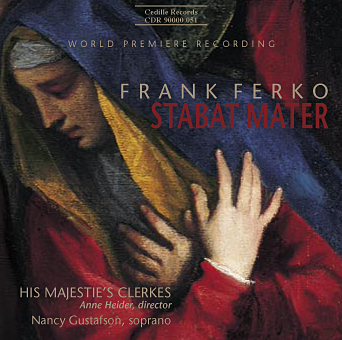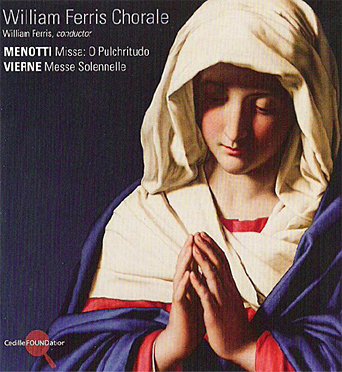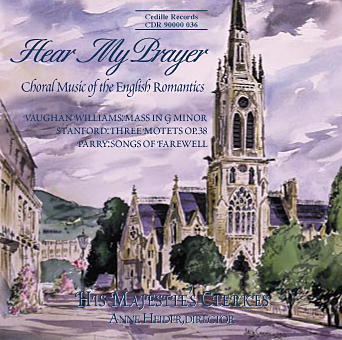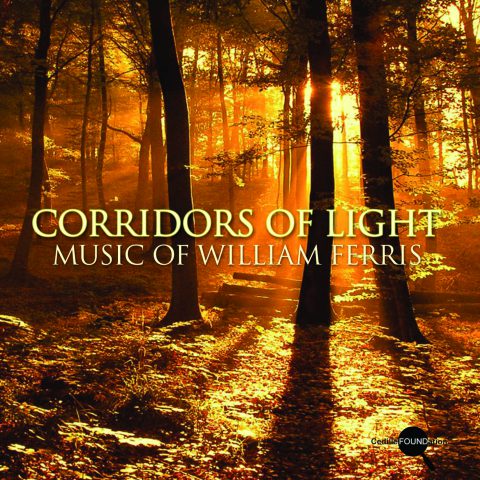Store

Store
Frank Ferko: Stabat Mater
Composer Frank Ferko’s majestic new Stabat Mater (The Mother Stood) broadens the embrace of this profound medieval hymn depicting Mary at the Crucifixion. Ferko supplements the original Latin text on the theme of premature death with passages from classical Greek drama and modern verse.
Ferko (b. 1950) composed his Stabat Mater in 1998 for the a capella mixed choir His Majestie’s Clerkes. The Chicago Tribune pronounced their concert premiere of Ferko’s Stabat Mater a classical highlight of 1999: “a marvelously intricate and sincerely devout tour de force that showed off the Clerke’s disciplined, sensitive, and uncommonly nuanced singing.” Writer Ted Shen asked rhetorically, “When will Frank Ferko be recognized for what he is, a talented and erudite innovator of old vocal genres?” With his fugal writing, Ferko “plays” the choir like an organ. Not surprisingly, Ferko is a veteran church organist and choral director as well as composer. He holds a doctorate in music composition from Northwestern University, where he studied with Alan Stout.
“Musically, Ferko’s Stabat Mater eschews trendy, stupefying ‘mystic minimalism,'” says Cedille Records producer Jim Ginsburg. “Its soaring, virtuosic choral scoring demands resiliency, vocal dexterity, and precision ensemble work.”
In his Stabat Mater, Ferko links the original Latin text to tragic events of the recent and distant past, inserting English texts by twentieth-century poets Padraic Pearse (on Irish political violence); Charlotte Mayerson (whose son died of AIDS); and Sally M. Gall, along with passages from the Gospel of St. Luke and Euripedes’ The Trojan Women (translated by Richmond Lattimore).
The work consists of 25 miniature pieces (20 Latin stanzas and five English interpolations) “that fit together much like a mosaic,” Ferko writes in the CD booklet. Musically, the composition employs “old-fashioned” concepts: tonal centers, church modes, major and minor keys, counterpoint, and melody. The music digresses occasionally, “but there is a basic tonal framework for the entire composition,” Ferko writes. He describes the tonal center as progressing through two “arches,” from E to B-flat and from B-flat back to E –“and beyond, in the final chorale.”
Preview Excerpts
FRANK FERKO
Stabat Mater
Artists
Program Notes
Download Album BookletStabat Mater
Notes by Frank Ferko
The twentieth century has produced relatively few concert settings of the Stabat Mater, a text that inspired so many composers in previous eras. When asked why I chose this ancient Latin hymn over other texts, the answer was simple. I saw in the Stabat Mater words that spoke of the pain and death of a young man, the grieving of his mother, and the hope of life after death. In my own mind, there was an immediate connection between this text and events from our time, and I wanted to compose a piece that would connect the Stabat Mater with the present.
At this point in history, and particularly in looking retrospectively at the twentieth century, it would be difficult for anyone to ignore the overwhelming number of children and young adults whose lives have been lost to the ravages of war, murder, suicide, and crimes of hatred, as well as to disease and tragic accidents of all kinds. For most of these premature deaths, there was a parent who grieved over the lost life. Upon reading the text of the Stabat Mater, one is immediately struck by the very somber, even morbid words that speak of pain and suffering, beating and torture, and eventually death. These ideas are repeated over and over again in an ever-changing poetic Latin vocabulary. There is also a feeling of waiting: the mother of Jesus waiting as her son slowly and painfully dies in front of her eyes. She is helpless in the situation, and can only stand and watch as the inevitable happens. How many people in our own time have had a similar experience, in a hospital room, on a battlefield, on a playground, or in the streets? To present the Stabat Mater in a way that would relate the medieval text to certain life experiences, I chose five additional texts — in English as it turned out — to interpolate into the context of the Latin hymn. I wish to point out that these interpolated pieces are optional additions and do not have to be included in any given performance. However, the work as a whole will lose a significant dimension of meaning and a connection with the present if the interpolations are omitted.
This work has its compositional roots in the past. It consists of 25 miniature pieces (20 Latin stanzas and 5 interpolations) that fit together much like a mosaic. The materials used include such old-fashioned concepts as tonal centers, church modes, major and minor keys, counterpoint, and melody. The music does digress into realms away from the tonal center (especially Stanza No. 13, which is atonal), but there is a basic tonal framework for the entire composition.
At the outset, the Introduction establishes the key of E minor, and E as the principal tonal center. Through various devices, the tonal center gradually shifts to the very distant key of B-flat minor, which we reach in Stanza No. 12, after which everything begins moving back to E minor. However, the final stanza, which expresses the hope of life after death, has been placed in the very “bright” key of D major; it acts as a kind of chorale, much like the chorales Bach used to conclude his Passions. Thus we have two arches: one progressing from E to B-flat, and the other progressing from B-flat back to E — and beyond, in the final chorale.
Throughout this work there is a constant interplay between musical whole steps and half steps. The rearrangement of these intervals has resulted in some interesting scales, such as the whole tone scale (which has no half steps at all) used in Stanza No. 9 (“Eia Mater”) and the octotonic scale introduced at the soprano soloist’s entrance in “Andromache’s Lament.” The very colorful octotonic scale is comprised of regularly alternating half steps and whole steps. It appears in an altered form in stanzas 5 and 6, sung by the women of the chorus, and is presented in its pure form in Stanza 11, as the chorus sings a melody written in that scale, based on the note B-flat. This stanza presents the very thin texture of the entire chorus singing in unison without any harmony — a sort of modern-day chant. A rhythmic feature of this stanza, and one that reappears later, is the grouping of a sixteenth note followed by two eighth notes and another sixteenth to form a short-longlong-short pattern.
A certain amount of free chromaticism occurs, particularly in “Andromache’s Lament” and Stanza 13, “Fac me tecum.” Stanza 13, written in ABA form, presents the densest music of the whole composition. It consists of a series of tone clusters (the A section) with a large 8-part static cluster (the B section) that gradually changes at the discretion of the conductor, concluding with the women singing a half-step cluster and the men singing a whole-step cluster (after which the A section is repeated). This is the only portion of the work that has no clear tonal center. The seemingly endless wall of sound begs for a resolution, and we wait for that resolution just as Mary waited as she watched her son slowly dying. Musical resolution does not come until the next stanza, which then projects the piece into its journey back towards the key of E minor. As tonal stability returns, certain compositional procedures also resurface. In Stanza 16, “Fac ut portem,” we hear another chant-like single-line melody, sung by the tenors. This is followed immediately by a 4-voice isorhythmic motet in which the tenors sing the chant melody again but in very long note values. The counterpoint is similar to the counterpoint presented in stanzas 3 and 12, and the shortlong-long-short rhythmic pattern also reappears as a feature of Stanza 16. Following the final interpolation, “Elegy,” the tenor melody from “Fac ut portem” forms the basis of Stanzas 17 and 18, which affirm the key area of E minor.
My main criterion for selecting English texts for interpolation were their relationship to the basic meaning of the Latin Stabat Mater. Set as an optional introduction to the whole work, the first text is taken from the Gospel According to St. Luke. It is Simeon’s prophecy at the Presentation of the infant Jesus in the temple. Simeon warned Mary that her son would cause her much suffering: “you too will be pierced to the heart.” The second interpolated text, excerpted from a speech in Euripides’ The Trojan Women, expresses the horror of innocent people being killed in wartime. In this scene, the Greeks have won the Trojan War and have begun taking Trojan women and chil- dren back to Greece as slaves. The Greeks have declared that no children of Trojan heroes may be allowed to live. Thus, they have taken the young son of Andromache, wife of the slain hero Hector. They will kill the boy by throwing him from the top of the wall that surrounds the city onto the rocks below. Andromache has requested one final visit with her baby before he is to die. Her speech has been set for soprano solo and chorus.
The third interpolated text, titled The Mother, was written by the Irish poet Padraic Pearse (1879- 1916). It tells of a mother whose two sons have gone to fight in a war for just causes. Although she does not begrudge them and respects them for their deed, both are killed. The mother ends up alone, grieving for her sons. Padraic Pearse was himself executed for his part in the fight for Irish independence following the Easter Rebellion of 1916. The fourth interpolation sets four short poems by Charlotte Mayerson, from her book The Death Cycle Machine, inspired by the loss of her son to AIDS in 1990. The viewpoint is very different from the preceding poems in that the author expresses both grief and anger: anger at the disease, anger with her son for not caring for himself as the disease progressed, and anger with God for allowing it all to happen. The final interpolation is a setting of Sally M. Gall’s Elegy, a poem in which the cause of the child’s death is only hinted at (drowning). The viewpoint is that of both the child and the parents. It provides a calmer view of death than the preceding texts and offers hope for something more beyond death.
The musical settings of the interpolated texts are entirely independent from those of the Latin text, even though their literary content is related to the Stabat Mater. The first, third, and fifth interpolations serve, in part, as tonal pillars, or reference points, for the singers. Thus, these interpolations are set homophonically, with very traditional harmonic progressions. The first serves to establish the tonal center of the whole piece; the third provides a reference point in the middle of the increasing chromaticism of the Latin stanzas.
The fifth interpolation, with its text expressing hope for life after death, foreshadows the final stanza and reflects the tonal stability that the main (Latin) work is gradually re-establishing. The second and fourth interpolations present highly dramatic texts requiring some use of chromaticism, dissonance, and rhythmic energy. Their musical settings provide a contrast to the surrounding music, but use musical constructions that have been heard earlier in the work. Of course, the second through fifth interpolations are also linked to each other through the timbral consistency of the added solo soprano voice.
Album Details
Total Time: 54:37
Recorded: August 18-20, 1999 at Mallinckrodt Chapel, Wilmette, IL
Producer: James Ginsburg
Engineer: Bill Maylone
Cover: Jacopo Palma il Giovane, Lamentation (c. 1620). © Board of Trustees, National Gallery of Art, Washington DC.
Design: Melanie Germond
Notes: Frank Ferko
© 2000 Cedille Records/Cedille Chicago
CDR 90000 051


